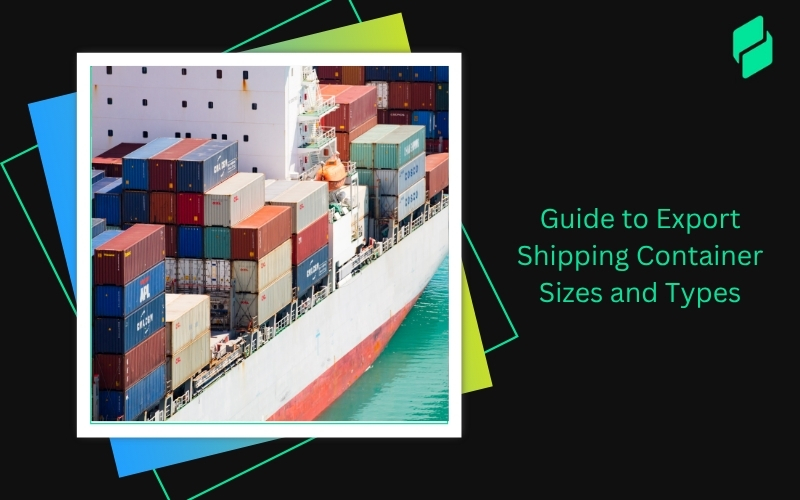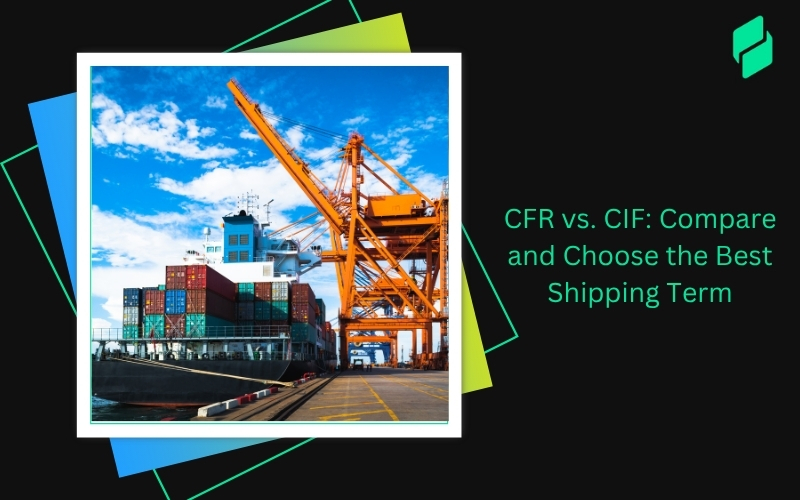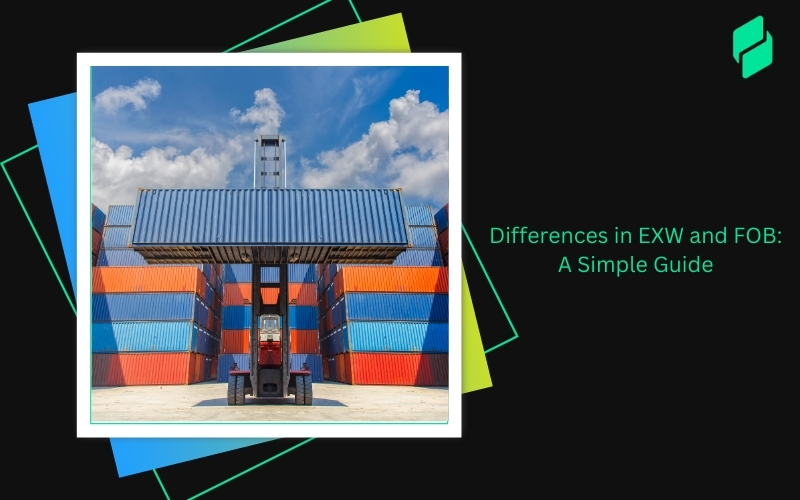Optimize your business: use unlimited savings with Pazago fulfilled now!
Get Started ->Have you ever needed clarification on the complexities of international shipping documents? You're not alone! One key document that often stirs questions is the Bill of Lading. This isn't just another piece of paper; it's the lifeline of global trade.
Think of it as your passport when shipping goods across borders. Are you ready to master this essential document?
Let's unpack its definition, importance, and the pivotal roles it plays in export shipments.
Definition and Importance of a Bill of Lading
A Bill of Lading (BL) might sound jargon, but it's crucial in shipping and trade. In simple terms, a BL is a document issued by a carrier to acknowledge cargo receipt for shipment. Why is it so important?
Without a BL, your goods are stuck without a way to legally prove their journey across seas or skies. It's a ticket that ensures your cargo can travel internationally without hitches.
Functions of Bill of Lading
When you issue a Bill of Lading, you're essentially wearing three hats: first, it is concrete evidence of the contract between you and the carrier.
Second, it is a receipt confirming the carrier has received the goods as described.
Lastly, it’s a crucial document of title, which means it can be used to transfer ownership of the goods. This trifecta role makes the BL not just a piece of paper but a powerful tool in the shipping industry.
Critical Roles of Bill of Lading within Export Shipment
Imagine you're sending a container of goods overseas. The BL guides the route and ensures that all parties involved, from the exporter to the carrier and the importer, are on the same page.
It dictates terms and conditions, thus minimizing disputes and smoothing out operations. It's the playbook everyone follows, ensuring each player knows their part in the logistics dance.
Bill of Lading Acts as Proof of Delivery, Contract of Carriage, and Ownership
The magic of the BL continues as it reaches the final stages of the shipment. This is undeniable proof that the goods were delivered according to the agreement.
Moreover, it outlines the specifics of the carriage contract, detailing everything from shipping conditions to delivery destinations.
And when it comes to ownership, the BL is like the master key, unlocking the rightful claim to the goods upon arrival.
Also Read: What Is Letter Of Credit In Export Import Business?
What's Inside a Bill of Lading? Unveiling Its Key Components

Let’s break down the essentials of what a BL should contain, ensuring your goods sail smoothly from port to port!
1. Shipper and Consignee Details
First things first, who's sending the goods, and who's receiving them? The BL must identify the shipper and the consignee and their complete addresses.
This helps track the shipment and ensures that all parties involved are appropriately documented for smooth operations and communication. Think of it as the 'who' in your shipping story.
2. Carrier Information
Who is responsible for transporting your goods? The carrier’s details, including their name and contact information, are crucial. This might be a shipping line, a freight forwarder, or a transporter type.
Knowing who's in charge of your cargo at sea is just as important as knowing what’s in your cargo.
3. Date of Shipment
Timing is everything in shipping! The date the goods were handed over to the carrier marks the official start of their journey. This data is crucial for tracking the shipment's progress and ensuring compliance with shipping schedules and deadlines.
4. Ports of Loading and Discharge
Where is your cargo headed, and where did its journey begin? The BL should list both the port of loading (where your goods are loaded onto the ship) and the port of discharge (where they are unloaded).
Also Read: Transshipment: A Comprehensive Guide to its Meaning, Process, and Importance in Global Trade
These geographical waypoints help you and the consignee track the route and prepare for arrival.
5. Description and Quantity of Goods
What exactly are you shipping, and how much of it is there? A detailed description of the goods, including the type of commodities and their packaging (like boxes, pallets, or drums), is fundamental.
Additionally, specifics about the quantity—be it in units, weight, or volume—must be clearly stated. This ensures everyone knows what to expect and helps in managing inventory.
6. Freight Charges
People prefer financial surprises, especially in shipping! The BL should specify the freight charges, or the cost of transportation, agreed upon between you and the carrier. This transparency of expenses helps with budgeting and avoids disputes over billing.
Also Read: Understanding Freight Charges and Costs [2024 Guide]
7. Terms and Conditions
Every shipment operates under a set of rules. The terms and conditions outlined in the BL cover the standard liability limits and regulations governing the shipment. This section is the backbone of your shipping process's legal and operational framework.
8. Title and Risk
When does the baton of responsibility for the cargo pass from the shipper to the carrier and eventually to the consignee? The BL specifies this transfer of title and risk, clarifying when each party is accountable for the goods. This is crucial for insurance and liability purposes.
9. Special Instructions
Do you have any specific needs for your cargo? Special instructions such as temperature controls for perishables, handling instructions for fragile items, or declarations for hazardous materials are noted here. This ensures that your goods receive the care they deserve.
10. Signature of Authorization
The final seal of approval comes with a signature. The BL must be signed and dated by an authorized carrier representative, confirming that they have received the goods as described and are committed to transporting them as agreed.
Need a more efficient way to manage your shipping documents? Explore Pazago Portal for seamless trade management solutions tailored for SME exporters and importers.
Also Read: What Is Shippers Letter Of Instruction
Navigating the Seas of Paperwork: Types of Bill of Lading Documents
Do you need clarification about the types of Bill of Lading (BL) documents you might encounter? You’re not alone. Every kind of BL plays a specific role in the shipping process, tailored to various shipment needs and legal requirements.
Let’s explore the various Bill of Lading documents you might need to handle.
Common Varieties: House, Surrender, Straight, Master, Blank
Starting, let’s look at some of the most commonly used BL types:
- House BL is issued by a freight forwarder detailing the goods received from the actual shipper.
- Surrender BL (or Express Release BL) allows cargo release to the consignee without presenting the original BL.
- Straight BL is non-negotiable and should be addressed directly to a specific consignee who must receive the shipment.
- Master BL is issued by the primary carrier of the goods when there are multiple handling agents.
- Blank BL has the consignee section left blank and is highly negotiable and risky.
Specialized Forms: Direct B/L, Shipper's Order B/L, Air Waybill
For specific shipping needs, these specialized forms come into play:
- Direct BL is used when the goods are shipped directly from the shipper to the consignee.
- Shipper's Order BL is negotiable and used when the goods are to be delivered to the order of a named entity.
- Air Waybill is for air cargo shipments, and unlike most BLs, it is not a document of title.
Comprehensive Options: Originals B/L, Land B/L, Multimodal/Combined Transport B/L
Handling multiple modes of transport or need proof of shipment?
- Originals BL refers to the hard copies required to release the cargo at the destination.
- Land BL is used for ground transportation in freight shipments.
- Multimodal/Combined Transport BL covers shipments involving more than one transport mode, such as sea and land.
Niche Types: Until the End B/L, Alternate B/L, Blank Endorsement B/L
For more unique shipping circumstances, consider:
- Until the end, BL will ensure that goods are transported and handed over to the final destination.
- Alternate BL provides flexibility in delivery options.
- Blank Endorsement BL allows the transfer of cargo ownership by signing the BL without naming a beneficiary.
Condition-Specific: Clean B/L, In Clause B/L, On Board B/L, On Deck B/L
Depending on the condition and loading specifics of the cargo:
- Clean BL indicates that the goods were received in good condition.
- In Clause, BL notes specific conditions or damages to the goods.
- On Board, BL confirms that the cargo has been loaded on the ship.
- On Deck, BL specifies goods on the ship's deck.
Digital Evolution: Telex Release
- Telex Release allows for the electronic release of goods, speeding up the process by eliminating the need for physical document delivery.
Which Bill of Lading suits your needs? Let Pazago guide you with expert insights and data on the best practices in international trade.
Understanding Payment Handling in Shipping: Freight Collect vs. Freight Pre-Paid
Whether you’re sending a small parcel or managing vast shipments, knowing the difference between freight collected and freight pre-paid can save you from unexpected costs and logistical nightmares.
Freight Collect vs. Freight Pre-Paid: What's the Difference?
Freight Collection means that the recipient of the goods is responsible for paying the shipping costs. This is settled upon the delivery of the cargo.
It’s like ordering a pizza and agreeing to pay once it arrives at your door. It is convenient for the sender but requires trust and arrangement with the receiver.
On the other hand, Freight Pre-Paid is when the shipper pays for the shipping costs upfront. Think of it as paying for your pizza when you place the order online. This method is often preferred when the shipper wants to control the budget or ensure no delays in shipment release due to payment issues upon arrival.
Also Read: Calculating Costs for Oversize Load Shipping and Freight Rates
Incoterms that Include Freight Collect and Freight Pre-Paid
Incoterms (International Commercial Terms) play a vital role in international trade by defining the responsibilities of buyers and sellers involved in shipping goods.
Different Incoterms dictate whether a shipment will be freight collected or freight pre-paid:
- Freight Collect: Terms like DAP (Delivered at Place), DDP (Delivered Duty Paid), and CFR (Cost and Freight) can often involve freight collection options, where the buyer needs to pay for the main carriage.
- Freight Pre-Paid: Terms like FOB (Free on Board), CIF (Cost, Insurance, and Freight), and CPT (Carriage Paid To) typically involve the seller paying for the transportation of goods up to a certain point in the journey.
Optimize your shipping costs and manage your freight payments efficiently with Pazago. Whether it's freight collection or freight pre-paid, Pazago's financial services offer clarity and control over your international trade finances.
Also Read: FOB vs CIF: What's The Difference? Which Is better?
Finalizing the Bill of Lading: A Detailed Guide to Seal the Deal
Preparing your Bill of Lading (BOL) correctly ensures smooth transit of your goods. Follow this structured guide to finalize your BOL, ensuring every detail is in place for a successful shipment.
1. Adding Detailed Order Information
- Purpose: Ensures all order details are accurately documented for tracking and verification.
- Details to Include: Order numbers, item descriptions, quantities, and special handling instructions.
- Importance: Helps in matching the shipment with purchase orders at various checkpoints.
2. Adding Details About the Actual Shipment
- Purpose: Provides a clear roadmap of the shipment's logistics.
- Details to Include: Mode of transport, expected routes, transit times, and packaging details.
- Importance: Ensures accurate logistical planning and that all handlers are informed about the shipment's specifics.
Also Read: Understanding Differences in Freight and Logistics Services
3. Handling Supplemental Pages for Extensive BOL Records
- Purpose: Manages additional information for large or complex shipments.
- Procedure: Mark supplemental pages and attach them to the main BOL document.
- Importance: Maintains coherence in documentation, ensuring all details are traceable and connected to the central BOL.
4. Adding Digital Signature and Company Seal
- Purpose: Validate the BOL with legally recognized signatures and company branding.
- Procedure: Use secure software to apply a digital signature and the company's seal.
- Importance: Enhances security and authenticity, reducing the risk of fraud and ensuring legal compliance.
5. Options for Downloading or Sharing the Document
- Purpose: Ensures all parties involved have access to the finalized BOL.
- Procedure: Download the BOL as a PDF and share it electronically with carriers, consignees, and stakeholders.
- Importance: Keeps all parties updated with the latest document version, minimizing errors and communication delays.
Finalizing your Bill of Lading is a critical step in export. Pazago's platform assists you in accurately preparing your BOL, ensuring that all details are in place for a successful shipment. Thus, it saves you time and reduces the risk of errors.
Implications of Filing a Bill of Lading Incorrectly: Avoid Costly Mistakes
Have you ever wondered what could happen if a Bill of Lading (BOL) is filed incorrectly? The consequences might be more significant than you think. Filing your BOL precisely is not just a recommendation; it's essential for smooth international trade.
Let's dive into why meticulous attention to your BOL is crucial and how errors can derail your shipping efforts.
The High Cost of Inaccuracy
Imagine you're sending a valuable shipment overseas. Now, what happens if the BOL needs to be revised? If details on the document don't match the actual shipment, the receiver could claim that the goods were damaged or incomplete upon arrival.
Here's the kicker: you, the shipper, are liable for these discrepancies. This could mean compensating the receiver or facing returns and reshipments, which are additional costs no business wants to incur.
Loss of Insurance Protection
One of the more severe implications of an incorrectly filed BOL is the potential loss of protection and indemnity insurance. This type of insurance is crucial for covering liabilities such as damage, loss, or injury related to cargo shipments.
If your BOL isn't up to snuff, your insurance provider might deny a claim, leaving you to face significant financial and legal repercussions.
Also Read: Understanding Freight Insurance Costs and Requirements
Legal Risks and Criminal Prosecution
Yes, it can get even more severe. If errors in the BOL are deemed fraudulent or negligent, you could face criminal prosecution. This isn't just about fines or penalties; it's about protecting your reputation and maintaining the legal standing of your business. Shipping laws are stringent, and compliance is non-negotiable.
How to Avoid These Pitfalls
So, how can you ensure your BOL is bulletproof? Here's a simple guide:
- Seek Expertise: Don't hesitate to consult with or hire a freight forwarder. These professionals have deep knowledge of export documents and procedures, ensuring flawless paperwork.
- Double-Check Details: Always double-check the information on your BOL. This includes quantities, descriptions, and conditions of the goods, as well as shipping dates and routes.
- Stay Informed: Keep abreast of any changes in shipping regulations and insurance requirements. This proactive approach can save you from making outdated or incorrect entries on your BOL.
Avoid costly mistakes in your Bill of Lading with Pazago's meticulous tracking and management features. Ensure precision and reliability in every transaction by joining Pazago.
Understanding Negotiable vs. Non-negotiable Bill of Lading: What You Need to Know
When it comes to international shipping, knowing whether to use a negotiable or non-negotiable Bill of Lading (BL) can be as critical as the contents of your shipment.
Each type of BL serves a distinct purpose, and choosing the right one can dramatically impact the flow of your transactions and the security of your goods. Are you ready to discover which one best suits your shipping needs?
Also Read: Import and Export Trade: Understanding its Impact and Strategies in India
How Do You Choose?
The choice between a negotiable and a non-negotiable BL depends mainly on the nature of your transaction:
- Consider a Negotiable BL if your goods might be sold during transit or if you need flexibility in managing ownership transfers. This is common in commodity trading or sizeable international business transactions.
- Opt for Non-Negotiable BL if the goods are sent directly to a specific buyer where no further ownership transfers are expected. This is typical in straightforward sales transactions where goods are paid for in advance or upon delivery.
Streamline your decision-making process on negotiable vs. non-negotiable Bills of Lading with Pazago Intel. Access detailed buyer and market data to make informed choices.
Conclusion
Now that you've navigated the complexities of creating a Bill of Lading (BL) use this knowledge to enhance your shipping operations and bolster your credibility. A well-prepared BL safeguards your transactions, minimizes risks, and ensures compliance. Embrace this document as a critical tool in your trade arsenal.
Ready to elevate your international trade operations? Connect with Pazago and leverage our integrated platform for SMEs like yours to grow and thrive in global markets.


.png)








